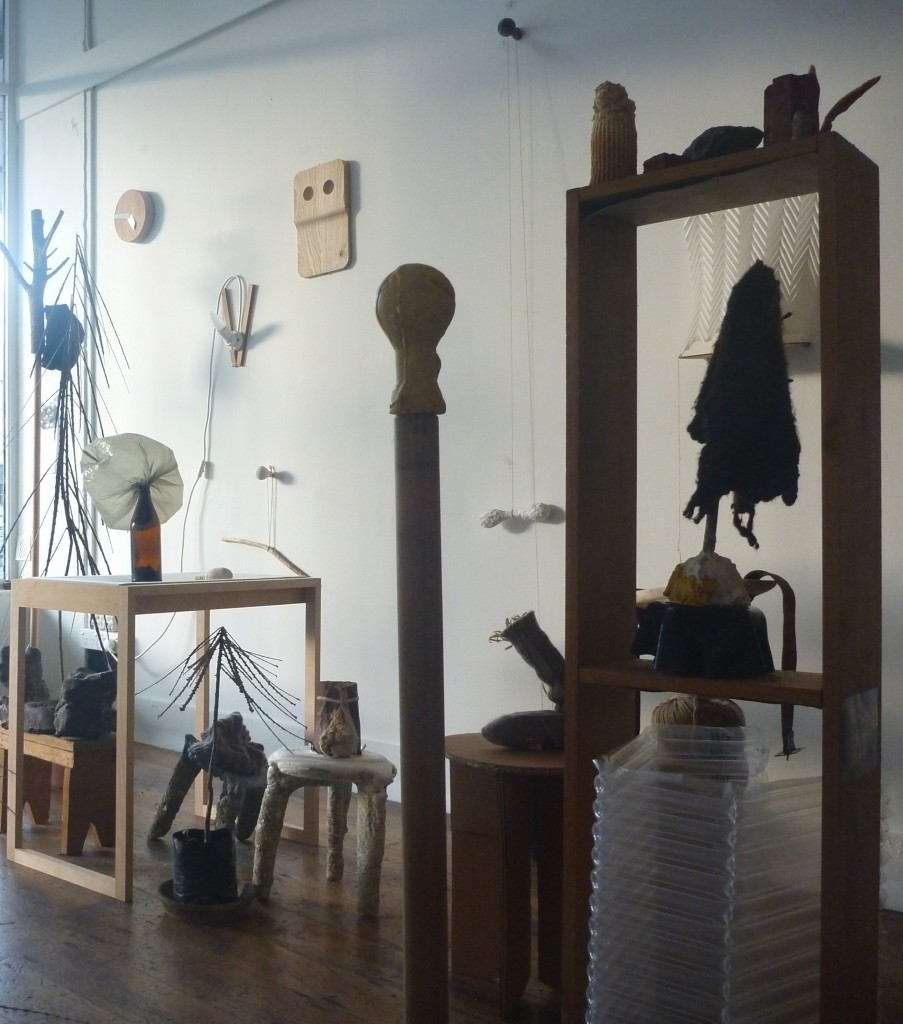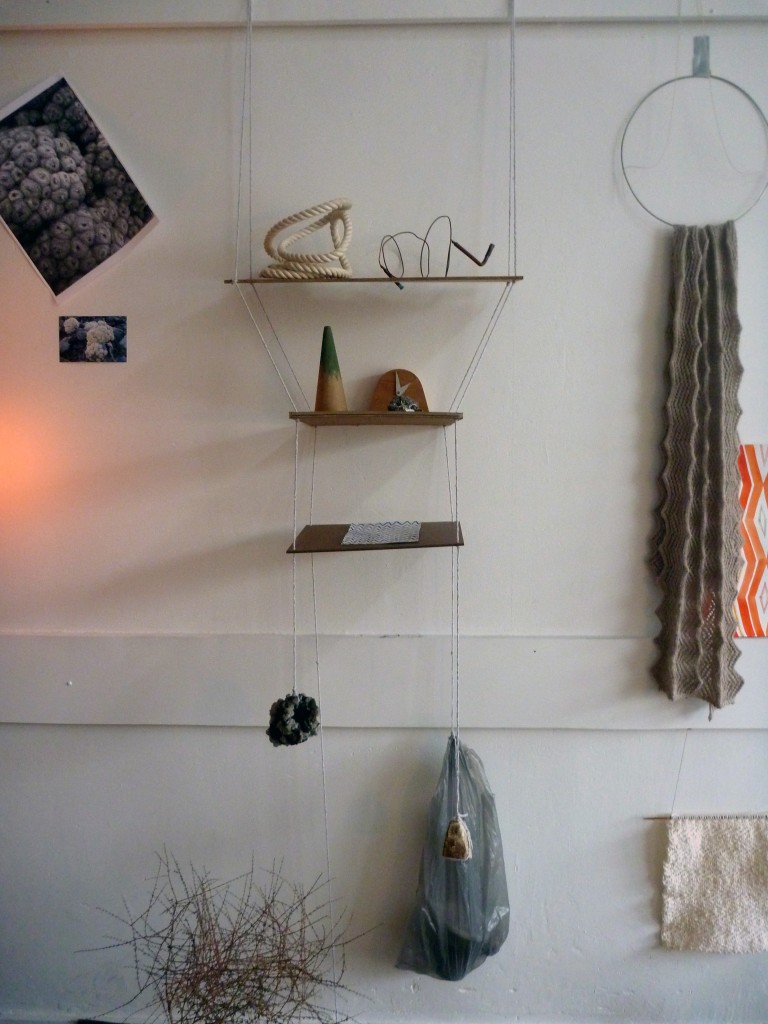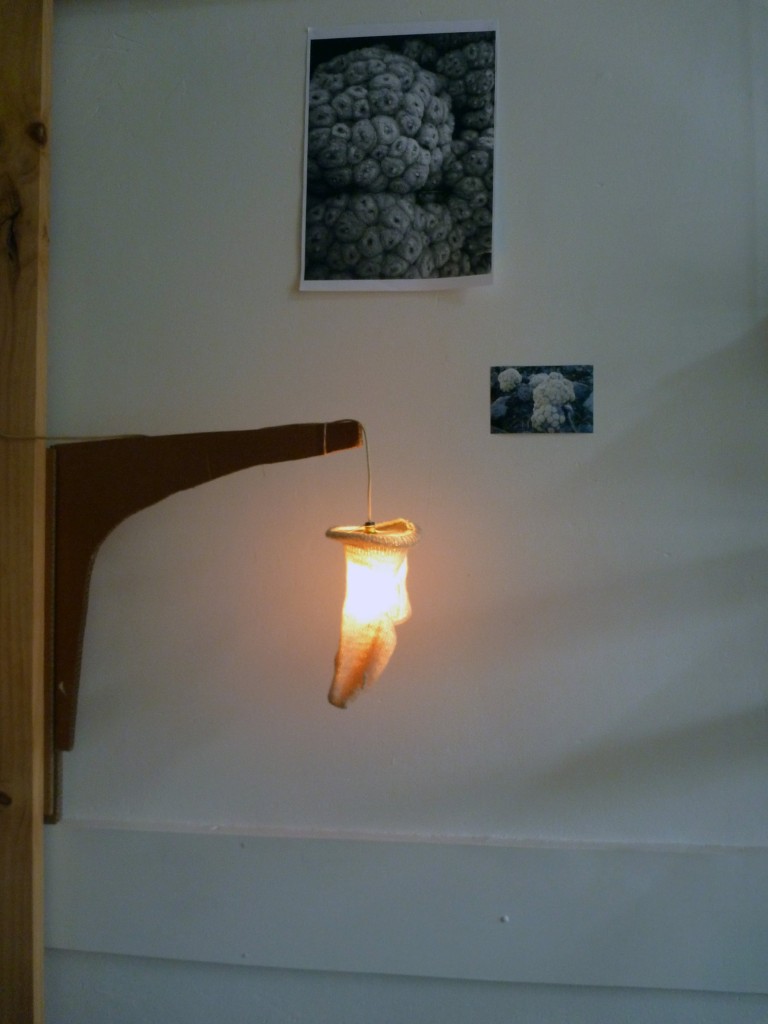Victoria Wynne-Jones

Xin Cheng, Mixtures, 2011. Images: Asumi Mizuo
Survival is a most serious business and is interrogated throughout the work of Auckland-based artist Xin Cheng. Cheng’s sculptural practice demonstrates a preoccupation with objects people often create to meet basic needs such as: shelter, illumination, warmth, support, nutrition and occasionally diversion Cheng’s solo exhibition, entitled Mixtures, involves a sprawling and scattered installation, a single work containing multitudes. The plenitude of Cheng’s work often makes it slightly bewildering; there are always so many different elements displayed in such varied and ingenuous ways. Due to its bulk and mode of display, it is physically difficult to move around this installation, one feels attacked on all sides. Cheng suspends multiple items from ceilings and walls; additionally many items are wide and consist of spindly outstretching parts. Cheng also un-helpfully places an assortment of mats on the floor creating the comedic dilemma of whether or not to walk upon the art. It is impossible to walk in a straight line or to wander around without having to duck and dodge objects.
There is furniture everywhere, sometimes it seems secure, at other times it is precarious and jerry-built creating a slightly threatening sense of unease. Mixtures involved the eccentric display of chairs improvised from various kinds of modelling material or sourced from second hand stores. Despite the fact that many of these objects have recognisable seats, they have often been crafted from strange materials, such as a solid piece of wood balanced upon a stack of plastic buckets or a volcanic crumble cavity atop a wooden stool. These chairs are visually intriguing, but terribly untrustworthy at the same time they do not seem capable of actually supporting a person’s weight. One wooden example even includes a belt so that one might be firmly buckled in, yet it still proves alarmingly insecure as it teeters upon a ball of yarn.[1] There are also tables crafted by Cheng in wood and corrugated cardboard, based on designs from books authored by Modernist titans such as Josef Albers (1888-1976). Cheng also exhibits a wide range of stands and shelves, some solid timber, others improvised from rope and small pieces of wood.[2] There is a tension between the seemingly usable and non-usable; all the objects and furniture presented are problematic. Yet there is also coherence to Mixtures, a transparency of materials and construction, one can easily see what something is made of and how it has been made. Due to the fact that she generally assembles or combines objects, Cheng’s installation is a collection of generally recognisable and plain materials: wood, twigs, cardboard, paper, wool, white plastic, twine, terracotta. Together these materials create a neutral, subtle and quietly varied palette.
Mixtures reads as a study in textures and techniques; besides furniture Cheng includes improvised wall hangings, branches, twigs, potted plants, knitted woollen lamp-covers, a felted sock, stumps of wood, useful-looking ropes, plastic bags, stones, drawings, bricks, lightbulb shapes, photocopied diagrams and possum-fur. The items have either been crafted by Cheng or sourced from hardware, thrift or craft stores. The improvised furniture, animal skins and damper twisted around sticks suggests survivalist outdoors pursuits and bush craft.[3] This is combined with multiple examples of knitting, as well as delicate shelves with fragile ceramics and folded paper shapes. By gently collecting and deftly making pieces of furniture, crude tools and covetable bibelots Cheng creates a zone of indiscernability where furniture, craft, discarded objects, art and images co-exist. Mixtures resembles an artisanal jumble sale of modernist cast-offs and Swiss Family Robinson-style handiwork.
An additional component of the exhibition is a cookbook collated by Cheng herself entitled Mixtures: a selection of recipes for making food without much equipment. This publication continues Cheng’s interest in improvising with limited means in order to create art, or more importantly, to eat. “This cookbook grew out of various situations where cooking is problematic, for example: travelling and not feeling rich enough to eat out; spending long hours in the studio.”[4] Here ingredients like materials must be skilfully recombined and altered in various permutations to different ends whether it be a nutritious and appealing snack or a successful installation. Whether one is dealing with seaweed, orange, beetroot and couscous or timber, modelling material, paper and plastic what matters is creativity and sympathy to materials, combinations and sensations.
Such preoccupations were elucidated by Cheng in a small essay she contributed to the Graduate Catalogue for the Elam School of Fine Arts. In this essay Cheng writes: “One of the fundamental problems confronted by the dedicated art student who spends long hours in the studio concerns the body of the maker itself: what can be done about the hunger requirements when you lack the time or money to eat out everyday?”[5] Here embodiment takes a thoroughly practical turn; Cheng takes the lessons she learnt in art school about problem solving and exploration of materials and applies them to everyday existence. In her post-script Cheng adds that an improvisational approach to materials was necessary while tramping up Mt. Aspiring; experiences such as repairing broken tent poles with twigs and bandages and using tent pegs to secure wet socks all fed back into her art practice. By sharing such an account as well as creating a practical cookbook Cheng’s practice involves a celebration of improvisation and play, perhaps an arte povera of survival.
Evident in Mixtures is what theorist Michel de Certeau (1925-1986) has called “a very ancient art of “making do.”[6] Just as Cheng probes the art of cooking with limited means, she also explores living and art-making in a similar manner. One strategy often utilised in the face of financial limitations is that of DIY or do-it-yourself, and the zealous and ingenious aesthetic of DIY as found on the internet or in library books holds an ongoing fascination for Cheng. Dwelling within the frequently awkward period of time that follows leaving art school Cheng fits the following situation described by de Certeau:
Without leaving the place where he has no choice but to live and
which lays down its law for him, he establishes within it a degree of
plurality and creativity. By an art of being in-between, he draws
unexpected results from his situation.[7]
Although perhaps the situation of having to make do is constant, whether at art school or not, travelling or at home.[8] Mixtures is an encounter with the traces of an artist turning the business of living in the world to her advantage, an idiosyncratic way of using or living within the “constraining order” of survival. Using existing objects for her own ends, each one has its own sense of logic, formality and inventiveness. There is also a slippage of these objects, they are rehabilitated, re-used and re-incorporated, migrating into different situations and exhibitions or put to good use in Cheng’s flat and everyday life. What really seems to interest Cheng is the process itself of making-do rather than the products; although her installations display these products aesthetically, what they actually exhibit is a myriad of techniques, processes, and attempts that are called upon when making-do.
Faced with problems such as how to be in the world and how to pass the time, Cheng responds tactically through her art practice, conflating basic human needs with the needs of the artist. As bricoleuse her responses include engaging in obscure and eccentric hobbies; delighting in creative and impish solutions to everyday problems; and compulsively collecting or crafting artefacts and tools, whether actually useful or merely quaint. Cheng blurs the line between work and leisure, between survival and art-making so that these activities flow together. One will often see her sporting some kind of bag or scarf she has ingeniously fashioned for herself, sometimes a tote bag with straps crafted from a man’s belt, another time a lady-like scarf made from the green velvet surface of a billiard table.
As a makeshift-museum, Mixtures champions art-objects as artefacts or tools created from seemingly out-moded means with dubious functions (although many of these techniques and similar objects are still being used in rural areas.) Cheng alternates easily between spinning, felting, knitting, cabinet-making, modelling and assembling. All of these processes involve a transformation of raw materials or existing objects into something else, perhaps something of use. For Cheng, enacting these processes of making allows her access to different ways of living (this is also the reason why she goes hiking from time to time.)[9] Always home-spun, her installations emphasise physical processes of making and collecting combined with the savvy media literacy of the twenty-first century. Perhaps what is really exhibited in this installation is the very contemporary combination of a justified fascination with multiple forms of thrifty making-do and access to an unprecedented amount of information about how to do so.
Mixtures demonstrates that art, like living and cooking is a matter of combining elements, a matter of mixtures, mosaics, aggregates, collections, a hybrid mishmash, conglomeration or assemblage. Combined with the daily business of staying alive are the pleasures of editing, problem-solving, gathering, selecting, collecting, cooking and making.


Xin Cheng, Mixtures, 2011. split/fountain, 13 May – 10 June 2011. Images: Asumi Mizuo
[1] In fact, this stool is based on a Swiss milking stool, the belt allows the sitter to move around with the seat without the use of one’s hands. See http://www.adambanks.com/wordpress/one-legged-milk-stool-design-museum/845/
[2] Some of these shelving ideas were taken from Victor Papanek’s Nomadic Furniture (1975).
[3] Damper is a kind of outdoor bush bread that is twisted around sticks and cooked over an open fire.
[4] Xin Cheng, Mixtures: a selection of recipes for making food without much equipment (Auckland: split/fountain, 2011) p. 3. Print.
[5] Xin Cheng, ‘Untitled Extract’ in Elam Graduate Work 2010 (Auckland: University of Auckland, 2011) p. 151. Print.
[6] Michel de Certeau, The Practice of Everyday Life Trans. Steven Kendall. (Berkeley: University of California Press, 1984) p. 30. Print.
[7] de Certeau, The Practice of Everyday Life p. 30.
[8] In an introduction to Article 27, an exhibition curated by Richard Dale for the Human Rights Commission at the Physics Room, Christchurch in 2009 Cheng elucidated this point: “Here is a collection of objects and books about things made by people in impoverished circumstances, where they were forced to innovate, and find alternative uses for whatever material they had at hand. The circumstances range from survival in the wild, to war, recession, poverty, social control, imprisonment and environmental crises. […] Ordinary people taking the initiative, using their own hands to solve problems they face. This kind of ingenuity and initiative is not limited to object-making either. There are community organisations, such as some factories, art galleries and studios that are set up to help the socially disadvantaged, those who are homeless, those with physical disabilities and those who suffer from mental illness. These initiatives use object-making as an aid, and offer a space for people to create and to socialise and to receive mentoring and support from professionals. I find objects like these have lot more meaning than those found in expensive design stores or art galleries.”
[9] Xin Cheng “hey!” Message to the author. 7 Nov. 2011. E-mail.
Originally from China, Xin Cheng currently lives and works in Auckland, New Zealand. A recent graduate from the Elam School of Fine Arts at the University of Auckland, Cheng has exhibited primarily in artist-run spaces in Auckland, Wellington and Christchurch. She is currently co-director of Rm, an artist run space on Karangahape Road.
Victoria Wynne-Jones lives in Auckland, New Zealand. She is currently writing her Masters thesis in Art History at the University of Auckland.